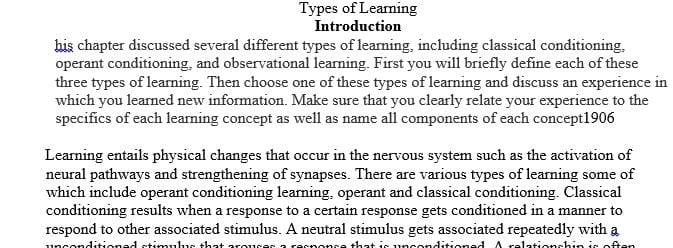Briefly define each of these three types of learning.
Chapter 7. Learning
This chapter discussed several different types of learning, including classical conditioning, operant conditioning, and observational learning. First you will briefly define each of these three types of learning. Then choose one of these types of learning and discuss an experience in which you learned new information. Make sure that you clearly relate your experience to the specifics of each learning concept as well as name all components of each concept.
Formatting instructions
Submit your paper through the Canvas website for this Psychology 1000 course
Submit only Word documents or PDF files! Other formats will not be able to be opened
The following items can cause point deductions:
Papers will be checked for plagiarism, which is a serious form of cheating
Manuscript should be 1.5 – 2 pages total length, nothing shorter or longer
Text must be double spaced with 1 inch margins
Typed in 12 point “Times New Roman” font
APA format of your textbook in the text of the paper
APA format reference section of book
Put your name on your paper (yes, this is still required even though you are posting online)
Additional Information and Hints For Your Paper.
Be creative with your example; do not adapt one presented in the book or use the one in the example.
You receive credit in the grading rubric for following simple formatting instructions, and for writing clearly and correctly. These are all good professional skills.
For your personal experience, do more than tell your story: Show explicitly how the information from the text applies to your own experience. Make a connection between the definitions and your example.
Look over the grading rubric to see how your paper will be evaluated before you write.
Use correct APA format to reference your textbook when citing information or concepts from the textbook. Since this writing assignment is not a full research report, it does not require all aspects of an APA formatted paper, such as a title page, abstract, table of contents, introduction, materials and methods, results or discussion sections.
What it will require is correct font, font size, spacing of text, correct margins, in text citation of your textbook and an APA formatted reference section including the text.
For more specific dos and don’ts of paper writing go to Read Me: Paper Writing Dos and Don’ts
Example paper
In chapter 7 of the textbook (insert citation), the principles of learning are discussed. These principles help to explain how learning occurs and even provides insight into how we can apply those principles to teach others and motivate ourselves to learn. In particular, there are three major categories of learning.
The first is Operant Conditioning, where reinforcement and punishments, or the consequences of an organism’s action, help to shape behaviors (insert citation). Positive reinforcement and punishment involve experiencing something pleasant or something unpleasant, respectively, to help shape behaviors. Negative reinforcement occurs when the consequence of a response is the removal of something aversive, subsequently resulting in an increased likelihood of that behavior, like taking an aspirin tablet to stop your headache. Negative punishment is the removal of something desirable to decrease a target behavior. If a parent makes a child stand in the corner as the consequence for doing something naughty, this hopefully stops the child from emitting that behavior in the future, because standing in the corner takes away the child’s ability to play.
The second type of learning is Classical Conditioning, when a neutral stimulus is repeatedly associated with an unconditioned stimulus, which elicits an unconditioned response. This pairing eventually produces a conditioned response, so that the originally neutral stimulus becomes a conditioned stimulus, itself causing the unconditioned response (insert citation). Lastly, observational learning occurs by simply watching another perform an action, and we copy them, like when people show us how to line dance (insert citation).
There is a Bernese mountain dog that I see occasionally whose name is Lio. He is a gentle giant, but he can also be a pest, since he loves my petting and affection a little too much. Whenever I pet him and stop briefly, he immediately starts grunting and squealing furiously. He also head-butts or pushes me with his paws. In response, I resume scratching him, and the head butting and noises stop. Initially I did not recognize that Lio was using Operant Conditioning on me, with head butting as a form of negative reinforcement. If I resumed scratching him, Lio stopped the obnoxious pushing. To avoid the pushing (taking away something unpleasant), I would resume petting and scratching him (increase the behavior).
As it turns out, most of the dogs I work with end up conditioning me, rather than the other way around. Nevertheless, knowing the principles of learning helps me to not only recognize when I am being conditioned by the dogs, but also recognize how I can actually teach them too.
(Place on Reference page on new page.)
Reference:
Schacter, D., Gilbert, D., Nock, M., Wegner, D. (2017). Psychology 4th Ed. New York, NY: Worth Publishers.
Answer preview to briefly define each of these three types of learning.
APA
406 words


